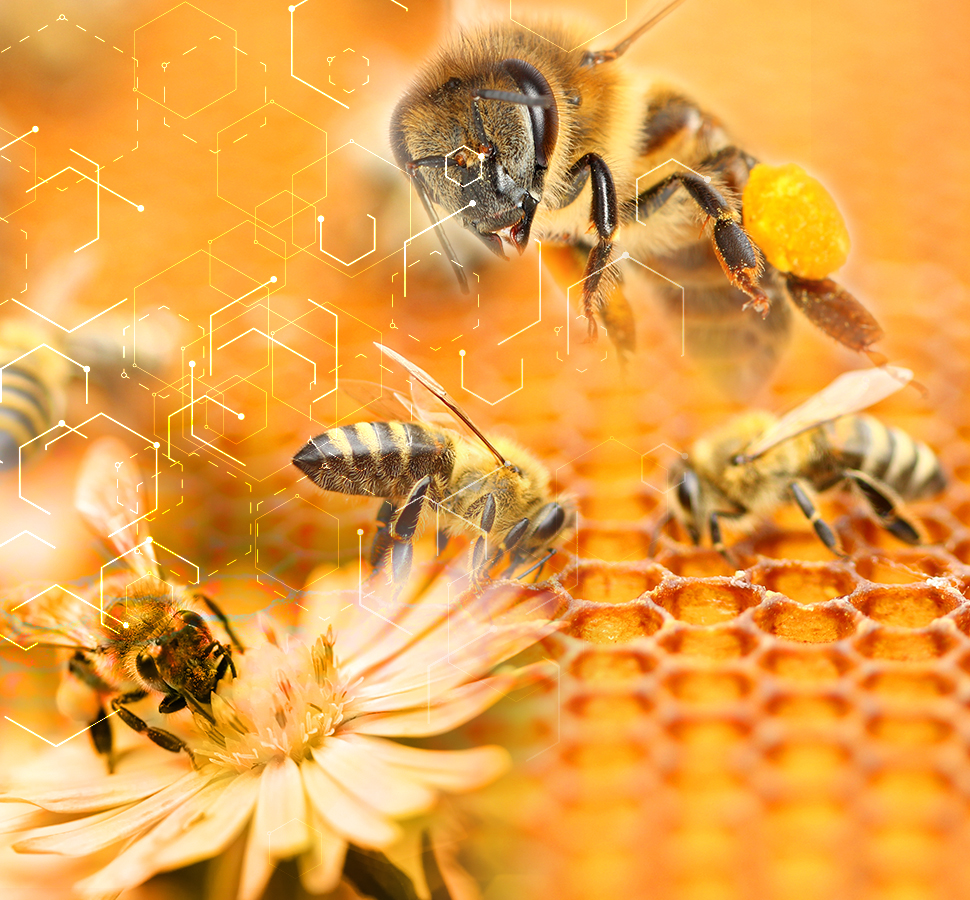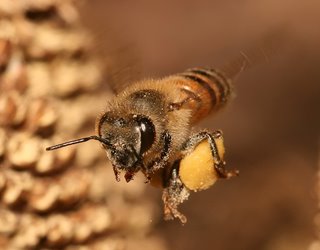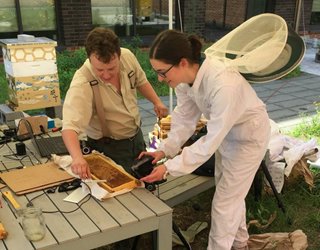Biomechanics of Pellet-Carrying Honeybees
Biomechanics of Pellet-Carrying Honeybees


Understanding how honeybees transport pollen pellets to their hive may inspire new ways to manufacture future soft materials.
To get pollen quickly and reliably to their hives, honeybees transform the pollen particles into a viscoelastic pellet.
The idea seems straightforward: A pellet is much easier to carry than the individual bits and pieces of pollen. It’s the transformation of particles into pellets that had David Hu, a professor of mechanical engineering at the school who researches the biomechanics of animal locomotion, and his students curious.
A method similar to the pellet-making process could one day be used to bind together the soft materials used to make robots, medical devices, and more, he said.
More for You: To Build a Beehive
“Honeybees collect pollen from flowers miles and miles away,” Hu said. “The pollen can change in size by a factor of 10. They must collect all these individual particles and bring it back to one place. And they must do a dozen foraging trips each day, all while keeping their bodies clean. They solve it all by this special method they created to exploit the pellet’s soft material properties,” he added.
The bees mix pollen with nectar and form the substance into a pellet. The pellet is firmly attached to the bees’ legs during flight, but it’s easily removed when it’s time for drop-off at the hive. They drop the pellets into a cell within the hive by carefully scraping them off using their other legs, Hu explained.
How do the honeybees achieve these contrary aims?
To find out, Marguerite Matherne, a recent Georgia Tech mechanical engineering Ph.D. graduate, tried to replicate the way honeybees remove the pellets from their hind legs. She and fellow researchers built a device that scraped pollen pellets from bee legs.
Watch a Video: Bioinspired Breakthroughs Transform Medical Devices
The invention produced two discoveries. The first was that honeybees remove pellets much easier than the lab-built scraping device does. The second was that slower removal speeds reduce the force and work required to remove pellets under stress.
“If you remove it slowly, you can avoid applying the excessive force required to remove it quickly,” Matherne said. “Removing a pollen pellet is like ripping off an adhesive bandage.”
The researchers also found, by measuring the viscoelastic material properties of a pollen pellet, that the pellets have a long relaxation time. “It means they remain mostly in a solid form during the transport process,” she said. “This is good because it keeps the pellet from melting or falling apart from vibration during flight.”
Another important factor to study: Honeybees collect and transport pollen particles of various shapes and sizes. Other species of bees only collect and carry specific types of similarly sized pollen particles. They also carry the particles differently than honeybees do, Hu added.
The research team believes further studies on the pellet could lead to new developments in soft materials that could be used for medical patches, fastener applications, soft robotics, and more.
“It’s kind of like smart gooey Velcro for soft materials,” Hu said. “It could be a fastener and it knows when you’re trying to remove it so that you don’t have to use an excessive amount of force.”
Editor’s Choice: 9 Bioinspired Medical Technologies
According to Matherne, the research adds insight into the pollinating process, which is important to study because 35 percent of the world’s crop production depends on pollinators.
Understanding the way honeybees make sticky pollen pellets can not only lead to soft-material fasteners, but can also help researchers discover ways to help keep honeybees populations high.
“Honeybees are really important pollinators,” she said. “If we want to create a world where we can keep up our pollinators, I think it’s important to understand exactly what they’re doing.”
Jean Thilmany is a science and technology writer based in living in St. Paul, Minn.
The idea seems straightforward: A pellet is much easier to carry than the individual bits and pieces of pollen. It’s the transformation of particles into pellets that had David Hu, a professor of mechanical engineering at the school who researches the biomechanics of animal locomotion, and his students curious.
A method similar to the pellet-making process could one day be used to bind together the soft materials used to make robots, medical devices, and more, he said.
More for You: To Build a Beehive
“Honeybees collect pollen from flowers miles and miles away,” Hu said. “The pollen can change in size by a factor of 10. They must collect all these individual particles and bring it back to one place. And they must do a dozen foraging trips each day, all while keeping their bodies clean. They solve it all by this special method they created to exploit the pellet’s soft material properties,” he added.
The bees mix pollen with nectar and form the substance into a pellet. The pellet is firmly attached to the bees’ legs during flight, but it’s easily removed when it’s time for drop-off at the hive. They drop the pellets into a cell within the hive by carefully scraping them off using their other legs, Hu explained.
How do the honeybees achieve these contrary aims?
To find out, Marguerite Matherne, a recent Georgia Tech mechanical engineering Ph.D. graduate, tried to replicate the way honeybees remove the pellets from their hind legs. She and fellow researchers built a device that scraped pollen pellets from bee legs.
Watch a Video: Bioinspired Breakthroughs Transform Medical Devices
The invention produced two discoveries. The first was that honeybees remove pellets much easier than the lab-built scraping device does. The second was that slower removal speeds reduce the force and work required to remove pellets under stress.
“If you remove it slowly, you can avoid applying the excessive force required to remove it quickly,” Matherne said. “Removing a pollen pellet is like ripping off an adhesive bandage.”
The researchers also found, by measuring the viscoelastic material properties of a pollen pellet, that the pellets have a long relaxation time. “It means they remain mostly in a solid form during the transport process,” she said. “This is good because it keeps the pellet from melting or falling apart from vibration during flight.”
Another important factor to study: Honeybees collect and transport pollen particles of various shapes and sizes. Other species of bees only collect and carry specific types of similarly sized pollen particles. They also carry the particles differently than honeybees do, Hu added.
The research team believes further studies on the pellet could lead to new developments in soft materials that could be used for medical patches, fastener applications, soft robotics, and more.
“It’s kind of like smart gooey Velcro for soft materials,” Hu said. “It could be a fastener and it knows when you’re trying to remove it so that you don’t have to use an excessive amount of force.”
Editor’s Choice: 9 Bioinspired Medical Technologies
According to Matherne, the research adds insight into the pollinating process, which is important to study because 35 percent of the world’s crop production depends on pollinators.
Understanding the way honeybees make sticky pollen pellets can not only lead to soft-material fasteners, but can also help researchers discover ways to help keep honeybees populations high.
“Honeybees are really important pollinators,” she said. “If we want to create a world where we can keep up our pollinators, I think it’s important to understand exactly what they’re doing.”
Jean Thilmany is a science and technology writer based in living in St. Paul, Minn.







